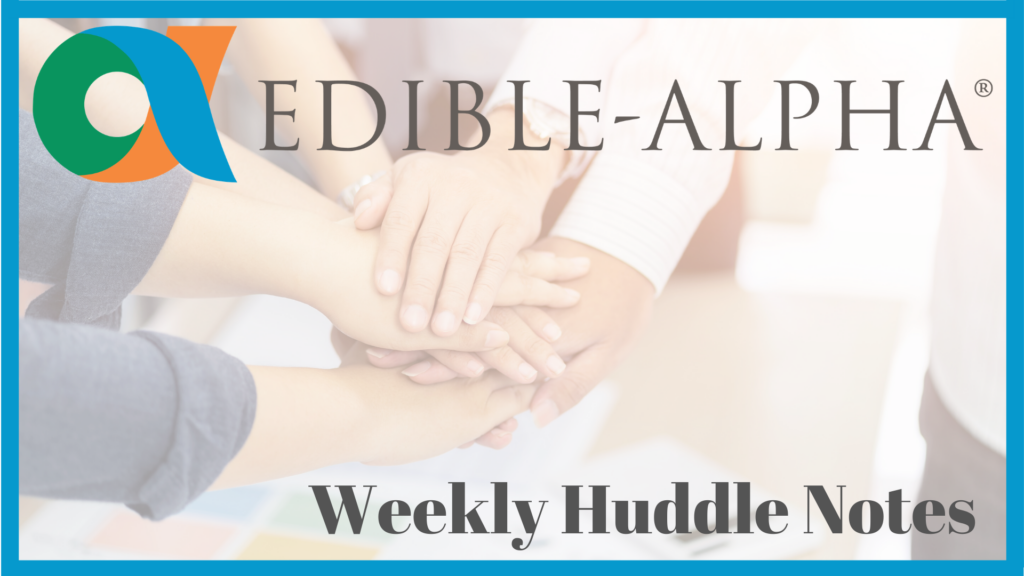The huddles this week focused on EIDL opening the application period back up for ag businesses only and Bartlett Durand on bankruptcy.
Talking Points
- EIDL – Applications opened back up, for farmers only! | More information
- Bankruptcy as a Tool: consultant and lawyer, Bartlett Durand, was a guest speaker on our consultant huddle. Find some key takeaways below |Watch the recording here
- Having an attorney to help guide you through the setup and the technical process is essential.
- Money can be set aside (especially for the attorney and any consultant fees) before creditors start pulling everything out for you.
- Spoon feed the attorney your plan to make the process as efficient as possible. This includes providing a full picture of your debt and associated guarantees, a list of all assets, your cash flow statement, and so on.
- If you have your finances prepped, you can save yourself a lot of time and money. Having a 13-week rolling cash flow is an integral piece of this.
- Sometimes the 13-week cash flow will show you, you’re not in such bad of shape!
- Things to consider and think about when you’re prepping your financials when considering bankruptcy:
- Is there a way to get the company back to being sustainable?
- If you remove creditors any lawyers (or other liabilities/expenses) from the equation, how long could you at least keep the business above water?
- There will be some things you can’t defer and will need to spend cash on like: loan interest, utilities, rent, etc., and especially your taxes!
- Bankruptcy can take 6+ months and keeps going until all your debts are paid off. You won’t always need to go to court if you only have a few creditors to work with but can still take time.
- Cooperate with your creditors. Your creditors will work with you to try to keep your business alive. If you cooperate to get the highest value for everything, the better things will be for you on the other side.
- You cannot let your creditors go backward (you must stick to your proposed payment plan – that is why it is important to know your cash flow and get this
right with expert support), if they see this happen during your bankruptcy plan process you will get forced into chapter 7 bankruptcy instead of 11. - Types of Bankruptcy
- Chapter 7 – liquidation. This is when there is no hope for the company and you need to sell it all, just keeping the minimum. LLCs and sole proprietors usually end up bankrupting together because of personal guarantees. If you used your grand/parents balance sheets then full debt can be transferred to mom, dad, grandpa, whoever signed that guarantee and to your spouse if their signature was required (i.e. Wisconsin marital law).
- Chapter 11 – Reorganization, business survival for big companies. You do this if you believe your business structure is going to change [because of COVID] and it won’t go back to where it was before, but you do have a good business model that is shown to cashflow again in time. You’re essentially proving to a judge that you have a plan and that your plan is going to be a success. Then you put that plan of action into place and hit objectives.
- Chapter 12 – equal payment over time. This is rarely used and mostly for farmers. Puts a fixed rate on loans to pay out over X amount of years.
- Chapter 13 – personal reorganization. This is primarily if you can stillbring in income but just can’t pay all the bills. Puts all your credit on holdto extend the terms to pay them out.
- Having an attorney to help guide you through the setup and the technical process is essential.
- Watch and Share! New FREE On-Demand Course – Getting Your Food Products Online
- Edible-Alpha® has created a short course introducing three key ways to sell food products online: your own direct to consumer site, Amazon, and other online sites. We discuss forming your online strategy, logistics and operational considerations, keywords, advertising and promotion, and metrics collection. We hope that this overview helps you start or grow your online sales.Trends
- Meat processing is getting worse – meat rationing is happening.
- Grants are shifting priorities to COVID
- Value Added Products and Goods (VAPG) – focus on resiliency
- Organic dairy is still going strong, conventional is being reduced by 15-20%
- Farms for the past 15 years thought they were profitable, but it was just their land prices increasing on their balance sheets. Now that land prices are softening, they’re realizing they weren’t actually making any money.
Tips - Read the fine print on your business lease to determine the implications of stopping payments, deferring payments, etc.Immediate Next Steps
- Listen to the recording of the Consultant Huddle for Bartlett’s full discussion onbankruptcy
- Listen to the Edible-Alpha® podcast Is Bankruptcy Best? How Food Businesses Can Decide with Bartlett Durand
- Work on your 13-week rolling cash flow, we’ve put together a free template and video that walks you through the process of making one
